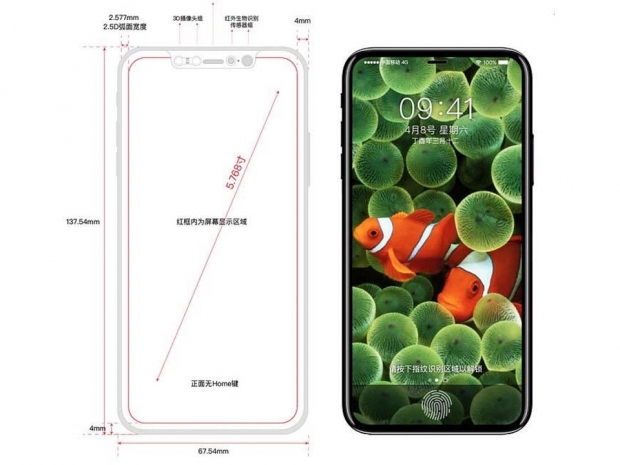Last week, a user on Weibo shared an image of a manufacturing related design of a 5.8-inch iPhone expected to be released later this year with an OLED display. The device’s dimensions were listed as 149.5mm tall, 72.5mm wide and 8.6mm thick (5.89 x 2.85 x 0.34 inches), which is slightly larger than the 4.7-inch iPhone 7, yet similar to the thickness of an iPhone 4.
This week, separate sketches originating from ifanr have appeared based on the previous renderings, though the artist drew the device slightly smaller in size than the first. This time, the ‘iPhone 8’ is shown as 137.54mm tall and 67.54mm wide, or nearly identical to the 4.7-inch iPhone 7 (138.3 x 67.1mm). The drawing also shows a bezel thickness of only 4mm between the in-built glass display and the edge of the device.
In addition, the rendering shows several components embedded within the display itself. These include the Touch ID sensor, front-facing camera, a small microphone hole, an ambient light sensor, a proximity sensor, and the rumored 3D sensor. Needless to say, all of these components are hidden behind the display except for the earpiece, which appears as a small notch cut-out at the top center of the display.
Source: ifanr.com
The backside of the rendering shows the same dual camera on the iPhone 7 Plus, but this time with the lenses stacked vertically rather than side-by-side, along with the LED flash placed in between them. As some commenters have noted, the increased separation of the lenses may aid with 3D and augmented reality features, as it would allow for an even wider viewing angle. But as with any leak, this information should be taken with a grain of salt until production begins on specific component orders.
Biometric authentication features to be determined
As we wrote last week, the fruit-themed toymaker has been struggling with low production yields on its Touch ID fingerprint hardware, leading some analysts to believe that the company may substitute the design with something less exciting if production problems can't be fixed. Apple is currently producing the solution in-house via its AuthenTec branch, which it bought back in 2012. The alternatives include switching to facial recognition via its rumored 3D sensor, moving the Touch ID fingerprint sensor to the back side of the device, or simply delaying production and attempting to explain its decision to investors.




